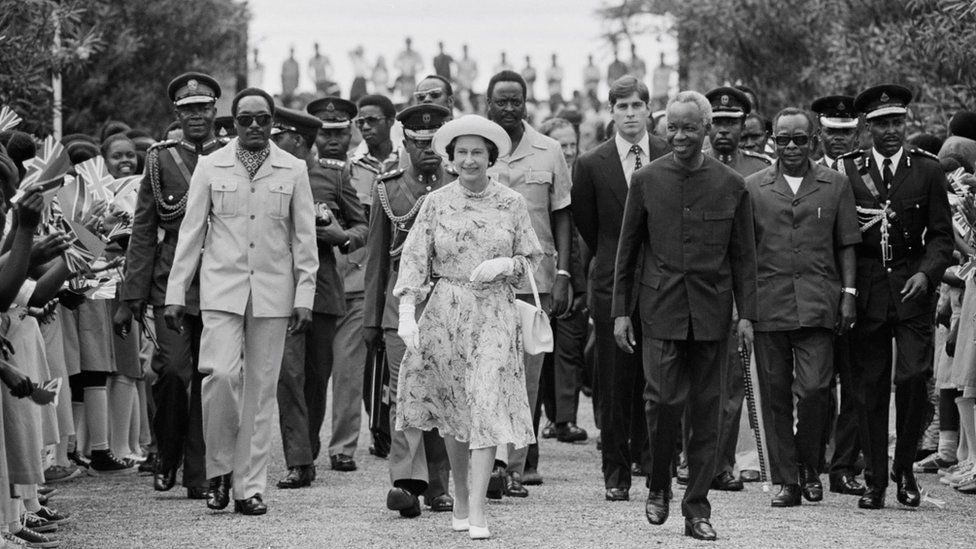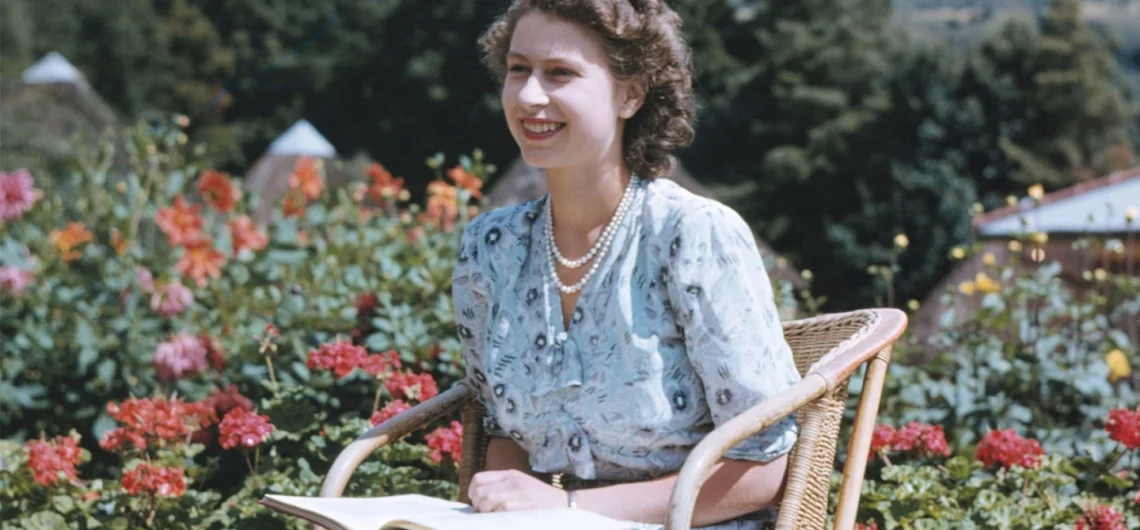Queen Elizabeth II, who ruled the UK for 70 years, passed away at Balmoral at the age of 96.
At her Scottish estate, where she had spent the majority of the summer, she passed away quietly on Thursday afternoon.
The Queen saw significant societal change after ascending to the throne in 1952.
It was a “time of tremendous anguish” for him and his family, according to her son King Charles III, and her loss will be “deeply felt” all around the world.
We deeply lament the loss of a beloved mother and beloved sovereign, he added.
He stated that he and his family will be “comforted and strengthened by our awareness of the respect and profound affection in which the Queen was so universally regarded” throughout the next period of grief.
The King will return to London on Friday with his wife Camilla, who is now Queen Consort, according to Buckingham Palace. On Friday, he’s scheduled to address the country.
After the Queen’s physicians expressed worry about her health earlier in the day, senior royals had assembled in Balmoral.
Following the Queen’s placement under medical supervision, all of her children made their way to Balmoral, which is close to Aberdeen.
Prince William, her great-grandson and current successor to the throne, as well as Prince Harry, gathered there.
The Queen, who on Tuesday named Liz Truss as prime minister, was described as the “rock” upon which modern Britain was created and as having “given us with the stability and strength that we required.”
She stated of the new King: “We offer him our allegiance and love, just as his mother so much and so long ago gave to so many.
And when the second Elizabethan era ends, we declare “God save the King,” just as Her Majesty would have wanted, to usher in a new chapter in the glorious history of our great nation.
The Church of England’s spiritual head, Justin Welby, who is also the monarch’s supreme governor, expressed his “deep regret.”
He remarked that “the King and the Royal Family are in my prayers.”
The reign of Queen Elizabeth II as head of state covered the post-World War II period of austerity, the change from an empire to a Commonwealth, the end of the Cold War, and the UK’s membership in – and exit from – the European Union.
15 prime ministers served during her time in office, including Ms. Truss, who was born 101 years after Winston Churchill, in 1874.
Throughout her rule, she met with her prime minister on a weekly basis.
Crowds waiting for information on the Queen’s condition at Buckingham Palace in London started wailing as they learned of her passing.
At 18:30 BST, a formal notice announcing the death was put outside, and the union flag flying over the palace was lowered to half-mast.
Prince William and his wife, Catherine, were made the Duke and Duchess of Cambridge and Cornwall upon the passing of the Queen.
Elizabeth Alexandra Mary Windsor was born the Queen on April 21, 1926, in Mayfair, London.
Few could have predicted she would become the monarch, but in December 1936, her uncle Edward VIII abdicated the monarchy in order to wed American Wallis Simpson, who had already been divorced twice.
Elizabeth’s father, King George VI, abdicated in favor of her sister Lilibet, who was heir to the throne at the age of 10.
Britain and Nazi Germany were at war in three years. After their parents rejected recommendations that they be moved to Canada, Elizabeth and her younger sister, Princess Margaret, spent a large portion of the war at Windsor Castle.
Elizabeth, who was then 18 years old, completed five months of training as a driver and basic mechanic with the Auxiliary Territorial Service. She subsequently said, “I started to comprehend the esprit de corps that thrives in the face of adversity.
She corresponded via letters with her third cousin Philip, Prince of Greece, who was enlisting in the Royal Navy, during the course of the conflict. The couple’s relationship flourished, and on November 20, 1947, they were married at Westminster Abbey, with the prince assuming the title of Duke of Edinburgh.
She would subsequently characterize him as “my strength and stay” over 74 years of marriage, before his death in 2021, aged 99.
Prince Charles now becomes King
Prince Charles has taken the throne in the wake of the Queen’s passing.
There will be a time of national mourning that will endure through the funeral, which is scheduled for ten days from now.
Her remains will be transported to Buckingham Palace, where they’ll probably stay for five days.
The premier league and other important events canceled for 2 weeks
In order to let the Queen take center stage, the government is not anticipated to announce any other business unless it is essential.
Now, important athletic activities like football and cricket games might be postponed out of respect.
The day she became a queen from a treehouse in Kenya
When her father passed away and she was crowned queen, Princess Elizabeth was deep in the Kenyan jungle on a once-in-a-lifetime excursion, seeing animals from high in the treetops. Elizabeth’s trip of the Commonwealth, which she undertook with Prince Philip in lieu of her ailing father, began in Kenya, a British territory at the time.
Queen Elizabeth II and Africa: A special relationship
Africa and Queen Elizabeth II shared a unique bond. When her father passed away and she took the kingdom, she was in Kenya. She had just turned 21 while on a trip to South Africa. She made many trips to Africa while serving as the British monarch.
During her reign, which coincided with the end of the British Empire and the spread of independence throughout the continent, Queen Elizabeth II traveled to more than 20 African nations. The Queen presided over the Commonwealth of Nations, which maintained a unique connection to Britain. The British monarchy had a strong, albeit tumultuous connection with post-colonial Africa.
Queen Elizabeth in Tanzania
Beginning of a three-day state visit by the Queen and Tanzanian President Julius Nyerere in 1979.
Dr. Nyerere, who eventually served as Tanganyika’s first president, guided the former British protectorate to independence eighteen years prior. He developed a stronger anti-British and anti-European sentiment over time.
However, the UK government saw him as a significant stabilizing element in an area that was becoming more unstable.

Related: Tanzania’s President H.E Samia Suluhu Hassan launches the Royal Tour Film
Did Queen Victoria hand Mount Kilimanjaro to Tanzania instead of Kenya?
According to unofficial claims, Queen Victoria is “allegedly” the reason why Kilimanjaro is in Tanzania and not in Kenya. The map of Kenya has an unusual thing about it. The boundary runs in a straight line from Lake Victoria to the coast, with just a slight twist. That inconspicuous slope would be meaningless if it didn’t neatly position Africa’s tallest mountain, Mount Kilimanjaro, on Tanzanian land.
The most common legend regarding how the crucial curve came to be is that Mount Kilimanjaro was handed to Queen Victoria’s nephew, the future Kaiser Wilhelm II of Prussia, as a birthday present. While the narrative is beautiful to a point and simple to cite as proof of the European countries’ arrogant attitude about Africa’s borders, it is incorrect.
The Tanzania-Kenya boundary exemplifies the haphazard character of the delineation procedure, which was eventually legitimized by an official mapping done in the early 1900s. While the Berlin Conference was undoubtedly a get-together when several nations divided Africa like a huge pie, the idea that the Queen gave away an entire snow-capped mountain on the spur of the moment is unfounded.
The position of Mount Kilimanjaro appears to have been agreed upon by Germany and Britain, with the sole point of controversy being where the dividing line from the peak to Lake Victoria terminated.
The British planned a railway that would run from Kilimanjaro to Speke Gulf, whereas the Germans offered a line that would run from Kilimanjaro to Musoma. A straight demarcation line from the northeastern corner of Lake Victoria to Mombasa is shown on another map from the German side. Kilimanjaro appears on both maps as part of what is now mainland Tanzania.
Was Kilimanjaro Mountain swapped for Mombasa Coastline?
Why Kilimanjaro is in Tanzania (1996) by Schneppen Heinz provides a more credible explanation for the oddity. “To put it another way, the Germans had conquered Kilimanjaro but not Mombasa, and the British had conquered Mombasa but not Kilimanjaro.” Kilimanjaro is now in Tanzania because Mombasa is in Kenya.” (See page 18)
Schneppen’s claim is based principally on the provisions of the 1 July 1890 Heligoland-Zanzibar Treaty.
Germany and the United Kingdom agreed on a number of territorial interests in the Treaty. In return for Heligoland and the coast of Dar es Salaam, Germany gave up its claim to the Sultanate of Zanzibar, which at the time extended to what is now Kenya’s coast.
Heligoland is a strategically important island that protects Germany’s North Sea naval stations. Wilhelm saw Heligoland as a key component of his strategy to outshine the British in naval might.
According to legend, the young prince grumbled to his grandmother about how she had two mountains but he had none. The matriarch, dubbed “Grandmother of Europe,” then commanded her followers to give the future Kaiser one high snow-capped mountain in East Africa.
A Victorian humorist was most likely responsible for this emotive “lavish royal gift” fable. It then grew in popularity as a marketing ploy popularized by tour operators and other tourism players.
Between the early 1880s until Germany’s loss in World War I, the country’s East African territory encompassed what is now Burundi, Rwanda, and mainland Tanzania, which was known as Tanganyika at the time. Britain used the Sultanate of Zanzibar as a stooge.
While the Heligoland Treaty makes no mention of a mountain, the delineation lines surrounding that area of the frontier do not appear to have changed. It is more likely that the Germans obtained Kilimanjaro by relinquishing their claim to Zanzibar and its whole Sultanate, which encompassed what is now the Kenyan Coast.
Because the treaty left them with the Dar es Salaam coast, Germany would not have been concerned about handing away the Sultanate’s coastline.
The legend of the Queen who gave her grandson a mountain has endured the test of time, yet it is fiction. While it typifies the excesses and arbitrary dividing that led to the formation of modern-day East Africa’s borders, there is no evidence to back it up. In the genuine story, there is a Guinness World Record. The pro-British Sultan Hamad died six years after the Heligoland Treaty and was succeeded by Sultan Khalid.
The British chose Hamud, another pro-British figure, and utilized a provision in the 1886 Zanzibar-Britain Treaty to give Khalid an ultimatum to quit.
The struggle to depose him began at 9 a.m. on August 27 and concluded at or before 9.40 a.m., a mere 40 minutes later, making it the world’s shortest war.
The Heligoland-Zanzibar Treaty put an end to Germany’s interests in the Sultanate of Zanzibar, which explains Schneppen’s claim that Mount Kilimanjaro was included in the trade, but unrecorded in the treaty’s provisions.
Related: Former U.K Prime Minister – Boris Johnson’s father, Stanley Johnson conquers Kilimanjaro.
![]()


Comments